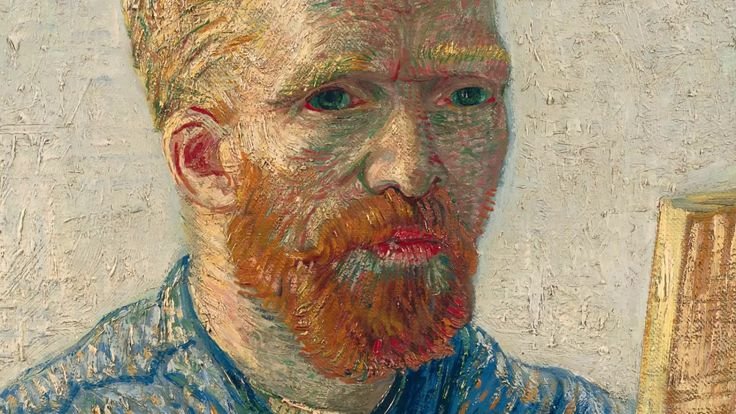Table of Contents
ToggleVincent van Gogh Biography: Birth, Education, Career, Family, and Net Worth
Vincent Willem van Gogh, born on March 30, 1853, in Zundert, Netherlands, was a post-impressionist painter whose work became among the most famous and influential in Western art history. Despite experiencing little success during his lifetime, van Gogh’s legacy has grown exponentially since his death, with his unique style and emotional depth captivating audiences worldwide.
Early Life and Education (1853-1880)
Vincent van Gogh was born to Theodorus van Gogh, a country minister, and Anna Cornelia Carbentus, an artist. He was the oldest of six children, with three sisters and two brothers. Growing up in a rural area, young Vincent was known to be a serious and thoughtful child, often found wandering the countryside alone.
Van Gogh’s formal education began at the village school in Zundert. At the age of 11, he was sent to a boarding school in Zevenbergen, where he studied French, English, and German. This early separation from his family was difficult for the sensitive boy, and it likely contributed to his later struggles with social interactions.
In 1868, at the age of 15, van Gogh abruptly left school and returned home. Despite his truncated formal education, he continued to read voraciously, developing a deep appreciation for literature and art. His early exposure to his mother’s artistic pursuits may have planted the seeds for his future career, though at this point, van Gogh had not yet considered becoming an artist himself.
From 1869 to 1873, van Gogh worked for the art dealer Goupil & Cie in The Hague. This position allowed him to travel to London and Paris, exposing him to the art world and furthering his education in an informal but profound way. During this time, he developed a keen eye for art and began to form opinions about various artistic styles and techniques.
Career Beginnings (1880-1885)
Van Gogh’s path to becoming an artist was not a straightforward one. After leaving his job at Goupil & Cie in 1876, he explored various career options, including teaching and working as a bookseller. He even considered becoming a pastor like his father, studying theology for a brief period.
It wasn’t until 1880, at the age of 27, that van Gogh decided to become an artist. This decision came after a period of deep personal crisis and soul-searching. He moved to Brussels to study art, focusing initially on drawing. His early works were mostly studies of peasant life, reflecting his empathy for the working class and his desire to capture the human condition in his art.
In 1881, van Gogh moved to The Hague to further his artistic education. He took lessons from his cousin-in-law, Anton Mauve, a successful artist of the Hague School. During this time, van Gogh experimented with various mediums, including watercolors and oil paints. His work from this period shows a growing confidence in his abilities and a developing personal style.
In 1883, van Gogh moved to the Dutch province of Drenthe, where he continued to paint rural scenes and landscapes. The following year, he returned to his parents’ home in Nuenen, where he would stay for two years. This period was marked by intense productivity, with van Gogh creating numerous paintings and drawings of peasant life, including his first major work, “The Potato Eaters” (1885).
Artistic Maturation (1886-1888)
In 1886, van Gogh moved to Paris to live with his brother Theo, who was working as an art dealer. This move proved to be a turning point in van Gogh’s artistic development. In Paris, he was exposed to the works of the Impressionists and Neo-Impressionists, which had a profound impact on his use of color and brushwork.
During his time in Paris, van Gogh’s style underwent a dramatic transformation. He abandoned the dark, earthy tones of his earlier Dutch period in favor of brighter, more vibrant colors. He began to experiment with new techniques, such as pointillism, and his subjects expanded to include urban scenes, portraits, and still lifes.
In Paris, van Gogh also met and befriended many other artists, including Paul Gauguin, Émile Bernard, and Henri de Toulouse-Lautrec. These relationships were crucial in shaping van Gogh’s artistic vision and providing him with a sense of camaraderie in the competitive Parisian art world.
The Arles Period (1888-1889)
In February 1888, van Gogh moved to Arles in the south of France, seeking the vibrant light and colors of Provence. This period marked the peak of his artistic career, during which he created some of his most famous works, including “Sunflowers,” “The Yellow House,” and “The Starry Night.”
In Arles, van Gogh’s style reached its full maturity. His use of color became even more expressive and symbolic, and his brushwork grew increasingly bold and energetic. He painted landscapes, portraits, and still lifes with a fervor that resulted in hundreds of canvases in just over a year.
It was during this time that van Gogh famously invited Paul Gauguin to join him in Arles, hoping to establish an artists’ colony. However, their relationship was tumultuous, and after a heated argument in December 1888, van Gogh famously cut off part of his own ear. This incident marked the beginning of a series of mental health crises that would plague van Gogh for the rest of his life.
Final Years (1889-1890)
Following the ear-cutting incident, van Gogh voluntarily admitted himself to the Saint-Paul-de-Mausole asylum in Saint-Rémy-de-Provence in May 1889. Despite his deteriorating mental health, van Gogh continued to paint prolifically during his time at the asylum. Some of his most famous works, including “The Starry Night” and “Irises,” were created during this period.
In May 1890, van Gogh left the asylum and moved to Auvers-sur-Oise, near Paris, to be closer to his brother Theo. Under the care of Dr. Paul Gachet, van Gogh experienced a final burst of creativity, producing more than 70 paintings in just over two months.
However, on July 27, 1890, van Gogh shot himself in the chest with a revolver. He died two days later, with his brother Theo by his side. His last words were reportedly “The sadness will last forever.”
Family
Vincent van Gogh’s family played a crucial role in his life and artistic career. His closest relationship was with his younger brother, Theo, who supported Vincent financially and emotionally throughout his life. Their correspondence, which has been preserved and published, provides invaluable insight into van Gogh’s thoughts, feelings, and artistic development.
Van Gogh’s parents, Theodorus and Anna, had a complex relationship with their eldest son. While they supported his early career attempts, they struggled to understand his decision to become an artist and were often concerned about his mental health and financial instability.
Van Gogh never married or had children. He had several romantic relationships throughout his life, including a complicated and ultimately heartbreaking involvement with his widowed cousin, Kee Vos-Stricker. Later, he lived with a prostitute named Sien Hoornik and her young daughter, considering them as his family for a time. However, these relationships were often tumultuous and short-lived.
Net Worth
During his lifetime, Vincent van Gogh sold only one painting, “The Red Vineyard,” for 400 francs (equivalent to about $2,000 in today’s currency). He lived in poverty for much of his adult life, relying on financial support from his brother Theo.
However, the value of van Gogh’s work has skyrocketed since his death. Today, his paintings are among the most expensive in the world. In 1990, his “Portrait of Dr. Gachet” sold for $82.5 million (equivalent to about $165 million in 2021), setting a record at the time for the most expensive painting ever sold.
While it’s impossible to calculate an exact “net worth” for van Gogh posthumously, the collective value of his known works would be in the billions of dollars. The Van Gogh Museum in Amsterdam alone, which houses the largest collection of his works, is estimated to have a collection worth over $6 billion.
Legacy and Influence
Vincent van Gogh’s impact on the art world cannot be overstated. His unique style, characterized by bold colors, expressive brushstrokes, and emotional intensity, helped pave the way for modern art movements such as Fauvism and Expressionism.
Van Gogh’s life story, marked by struggle, passion, and tragedy, has captivated the public imagination, making him one of the most famous artists in history. His letters to his brother Theo have been published and widely read, providing insight into his artistic process and personal life.
Today, van Gogh’s works are housed in museums around the world, with the largest collections at the Van Gogh Museum in Amsterdam and the Kröller-Müller Museum in Otterlo. His paintings continue to draw millions of visitors annually, and his influence can be seen in various forms of popular culture, from films and books to merchandise and advertising.
Van Gogh’s story serves as a poignant reminder of the often difficult relationship between artistic genius and mental health. His struggles with what is now believed to have been bipolar disorder, coupled with his unwavering dedication to his art, have made him a symbol of the tortured artist archetype.
Frequently Asked Questions
How many paintings did Vincent van Gogh create? Van Gogh created about 2,100 artworks, including around 850 oil paintings, most of them in the last decade of his life.
What was Vincent van Gogh’s most famous painting?
While this is subjective, “The Starry Night” is often considered van Gogh’s most famous work. Other well-known paintings include “Sunflowers,” “The Potato Eaters,” and “Cafe Terrace at Night.”
Did Vincent van Gogh really cut off his ear?
Yes, van Gogh cut off part of his left ear in December 1888 following an argument with Paul Gauguin. The exact circumstances and extent of the injury remain topics of debate among historians.
How many paintings did van Gogh sell during his lifetime?
Van Gogh is known to have sold only one painting during his lifetime, “The Red Vineyard,” to Anna Boch, a Belgian artist and art collector.
What was van Gogh’s mental health condition?
While a definitive diagnosis is impossible to make posthumously, many experts believe van Gogh suffered from bipolar disorder, possibly combined with other conditions such as epilepsy or borderline personality disorder.
Who was Theo van Gogh?
Theo van Gogh was Vincent’s younger brother and closest confidant. An art dealer, Theo supported Vincent financially throughout his career and was instrumental in preserving and promoting his work after his death.
What painting techniques did van Gogh use?
Van Gogh is known for his bold, expressive brushstrokes and vibrant use of color. He often applied paint thickly, a technique known as impasto, and used complementary colors to create visual contrast and intensity.
Where can I see van Gogh’s original paintings?
The largest collections of van Gogh’s work are at the Van Gogh Museum in Amsterdam and the Kröller-Müller Museum in Otterlo, Netherlands. His paintings can also be found in major museums worldwide, including the Musée d’Orsay in Paris and the Museum of Modern Art in New York.
How did van Gogh’s style change over time?
Van Gogh’s early work was characterized by dark, earthy tones and focused on peasant life. After moving to Paris and being exposed to Impressionism, his style evolved to include brighter colors and more varied subjects. His later work in Arles and Saint-Rémy is known for its bold colors, expressive brushwork, and emotional intensity.
What was van Gogh’s relationship with Paul Gauguin?
Van Gogh and Gauguin were friends and fellow artists who lived and worked together briefly in Arles. Their relationship was intense and often turbulent, culminating in a famous argument that preceded van Gogh’s ear-cutting incident.






